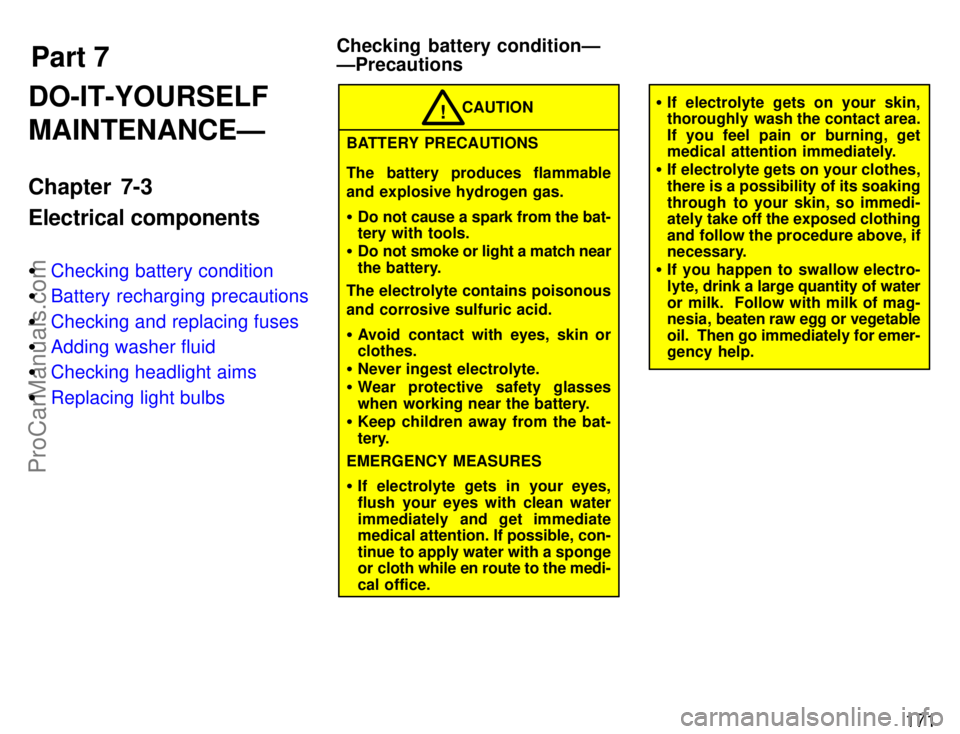Page 166 of 203

159
Checking power steering fluid
Parts (if level is low):
�Automatic transmission fluid DEX-
RON
[II or III
Tools:
� Rag or paper towel
� Funnel (only for adding fluid)
Checking battery condition
Non-maintenance batteriesÐ
Tools:
� Warm water
� Baking soda
� Grease
� Conventional wrench (for terminal
clamp bolts)
Maintenance type batteriesÐ
Parts (if level is low):
� Distilled water
Tools:
� Warm water
� Baking soda
� Grease
� Conventional wrench (for terminal
clamp bolts)
� Coin (for vent plugs)
� Funnel (only for adding distilled water) Checking and replacing fuses
Parts (if replacement is necessary):
�
Fuse with the same amperage rating
as original
Tools:
� Screwdriver (for passenger's side kick
panel screw)
Adding washer fluid
Parts:
� Water
� Washer fluid containing antifreeze (for
winter use)
Tools:
� Funnel
Replacing light bulbs
Parts:
� Bulb with same number and wattage
rating as original (See charts in Re-
placing light bulbsº in Chapter 7-3.)
Tools:
� Screwdriver
� Conventional wrench
ProCarManuals.com
Page 178 of 203

Part 7Checking battery conditionÐ
ÐPrecautions171
DO-IT-YOURSELF
MAINTENANCEÐ
Chapter 7-3
Electrical components
�Checking battery condition
� Battery recharging precautions
� Checking and replacing fuses
� Adding washer fluid
� Checking headlight aims
� Replacing light bulbs
BATTERY PRECAUTIONS
The battery produces flammable
and explosive hydrogen gas.
�Do not cause a spark from the bat-
tery with tools.
� Do not smoke or light a match near
the battery.
The electrolyte contains poisonous
and corrosive sulfuric acid.
� Avoid contact with eyes, skin or
clothes.
� Never ingest electrolyte.
� Wear protective safety glasses
when working near the battery.
� Keep children away from the bat-
tery.
EMERGENCY MEASURES
� If electrolyte gets in your eyes,
flush your eyes with clean water
immediately and get immediate
medical attention. If possible, con-
tinue to apply water with a sponge
or cloth while en route to the medi-
cal office. CAUTION
!�
If electrolyte gets on your skin,
thoroughly wash the contact area.
If you feel pain or burning, get
medical attention immediately.
� If electrolyte gets on your clothes,
there is a possibility of its soaking
through to your skin, so immedi-
ately take off the exposed clothing
and follow the procedure above, if
necessary.
� If you happen to swallow electro-
lyte, drink a large quantity of water
or milk. Follow with milk of mag-
nesia, beaten raw egg or vegetable
oil. Then go immediately for emer-
gency help.
ProCarManuals.com
Page 182 of 203

175
If the headlights or other electrical
components do not work, check the
fuses. If any of the fuses are blown,
they must be replaced.
See Fuse locationsº in Chapter 7-1 for
locations of the fuses.
Turn the ignition switch and inopera-
tive component off. Pull a suspected
fuse straight out and check it.
Determine which fuse may be causing the
problem. The lid of the fuse box shows the
name of the circuit for each fuse. See Part
8 of this manual for the functions con-
trolled by each circuit.
Type A fuses can be pulled out by using
the pull-out tool. The location of the pull-
out tool is shown in the illustration. If you are not sure whether the fuse has
blown, try replacing the suspected fuse
with one that you know is good.
If the fuse has blown, push a new fuse
into the clip.
Only install a fuse with the amperage rat-
ing designated on the fuse box lid.
If you do not have a spare fuse, in an
emergency you can pull out the CIG &
RADº, DOMEº or HTRº fuse, which may
be dispensable for normal driving, and
use it if its amperage rating is the same.
If you cannot use one of the same amper-
age, use one that is lower, but as close as
possible to the rating. If the amperage is
lower than that specified, the fuse might
blow out again but this does not indicate
anything
wrong. Be sure to get the correct
fuse as soon as possible and return the
substitute to its original clip.
It is a good idea to purchase a set of spare
fuses and keep them in your vehicle for
emergencies.
If the new fuse immediately blows out,
there is a problem with the electrical sys-
tem. Have your Toyota dealer correct it as
soon as possible.
Checking and replacing fuses
ProCarManuals.com
Page 194 of 203
Part 8
187
SPECIFICATIONS
�Dimensions and weight
� Engine
� Fuel
� Service specifications
� Tires
� Fuses
ProCarManuals.com
Page 199 of 203
192
Tire size:Spare tireU.S.A. T125/70D16
Canada
7A-FE engine 185/70R14 88S
P185/70R14 87S
205/55R15 87V
P205/55R15 87V
5S-FE engine
205/55R15 87V
P205/55R15 87V
Except spare tire
7A-FE engine185/70R14 88S
P185/70R14 87S
205/55R15 87V
P205/55R15 87V
5S-FE engine
205/55R15 87V
P205/55R15 87V Tire pressure, kPa (kgf/cm2 or bar, psi):
185/70R14 88S and P185/70R14 87S Front 200 (2.0, 29)
Rear 200 (2.0, 29)
205/55R15 87V and P205/55R15 87V
Front 230 (2.3, 33)
Rear 230 (2.3, 33)
T125/70D16 420 (4.2, 60)
Wheel size:
185/70R14 88S and P185/70R14 87S 14 x 6JJ
205/55R15 87V and P205/55R15 87V
15 x 6 1/2JJ
15 x 7JJ
T125/70D16
16 x 4T
Wheel nut torque, NV m (kgfVm, ftVlbf):
103 (10.5, 76)
Engine compartment (left)-U.S.A.
Tires Fuses
ProCarManuals.com
Page 200 of 203
193
Fuses (type A)
1 AM2 30 A: Starting system
2 HAZARD 10A: Emergency flashers
3 HORN 7.5 A: Horns
4 Radio NO.1 20 A: Car audio system
5 ECU-B 15 A: Anti-lock brake system,
cruise control system
6 DOME 10 A: Interior lights, personal
lights, luggage compartment light, trunk
light, door courtesy lights, clock
7 HEAD (LH) 15 A: Left-hand headlight
8 HEAD (RH) 15 A: Right-hand head-
light9 SPARE: Spare fuse
10 SPARE: Spare fuse
11 SPARE: Spare fuse
12 ALT-S 7.5 A: Charging system
13 SRS WRN 7.5 A: SRS airbag warning
light
14 EFI 15 A: Multiport fuel injection sys-
tem/sequential multiport fuel injection
system
15 HEAD (LH) LO 15 A: Left-hand head-
light (low beam)
16 HEAD (RH) LO 15 A: Right-hand
headlight (low beam)
17 HEAD-HI (RH) 15 A: Right-hand
headlight (high beam)
ProCarManuals.com
Page 201 of 203

194
18 HEAD-HI (LH) 15 A: Left-hand
headlight (high beam)
19 DRL 7.5 A: Daytime running light sys-
tem
20 ECU-IG 15 A: Electronically con-
trolled automatic transmission system,
anti-lock brake system
21 SEAT-HTR 20 A: No circuit
22 PANEL 7.5 A: Instrument panel lights
23 STOP 15 A: Stop lights, high mounted
stoplight, multiport fuel injection system/
sequential multiport fuel injection system,
cruise control system cancel device, elec-
tronically controlled automatic transmis-
sion system, anti-lock brake system 24 FOG 20 A: Front fog lights
25 CIG & RAD 15 A: Cigarette lighter,
dig-
ital clock display, car audio system
26 IGN 7.5 A: Charging system, dis-
charge warning light, multiport fuel injec-
tion system/sequential multiport fuel in-
jection system, SRS airbag system
27 WIPER 20 A: Windshield wipers and
washer, rear window wiper and washer
28 MIR-HTR 10 A: Multiport fuel injection
system/sequential multiport fuel injection
system
29 TURN 10 A: Turn signal lights, emer-
gency flashers
30 TAIL 15 A: Tail lights, parking lights,
front side marker lights, rear side marker
lights, license plate lights
31 HTR 10 A: Air conditioning system,
rear window defogger
32 GAUGE 10 A: Gauges and meters,
power door lock system
33 ST 7.5 A: Starting system, multiport
fuel injection system/sequential multiport
fuel injection system
34 A/C 10 A: Air conditioning system
35 OBD II 7.5A: On-board diagnosis sys-
tem Fuses (type B)
36 RDI 30 A: Electric cooling fan
37 CDS 30 A: Electric cooling fan
38 AM1 40 A:
Electronic ignition system/
distributor ignition system
39 DOOR 30 A: Power door lock system,
convertible top control system
40 DEF 30 A: Rear window defogger
41 POWER 30 A: Power windows, elec-
tric moon roof
Fuses (type C)
42 HTR 40 A: Air conditioning system
43 ALT 100 A: ALT-Sº, TAILº, DOORº,
DEFº and POWERº fuses
44 MAIN 60 A: Starting system, head-
lights, AM2º, HAZARDº, HORNº,
DOMEº and RADIOº fuses
45 ABS 50 A: Anti-lock brake system
ProCarManuals.com